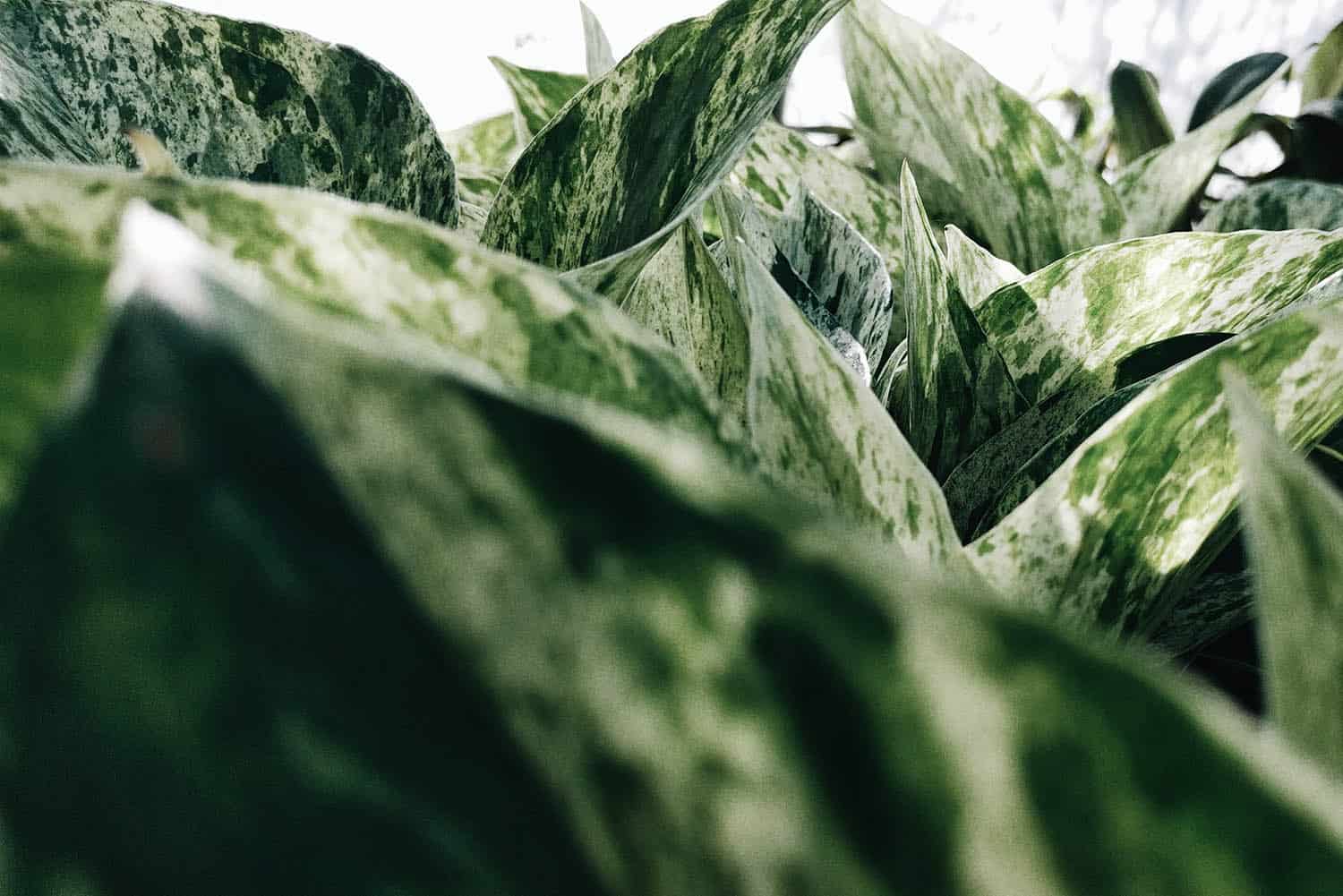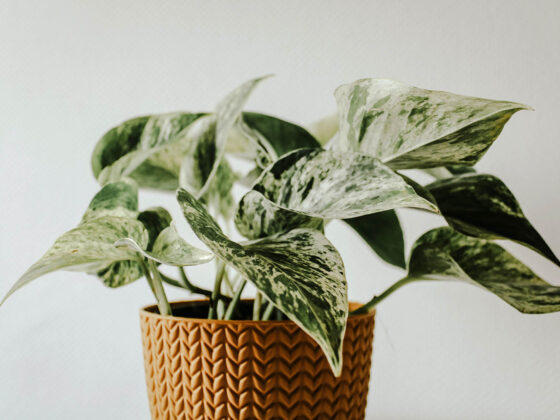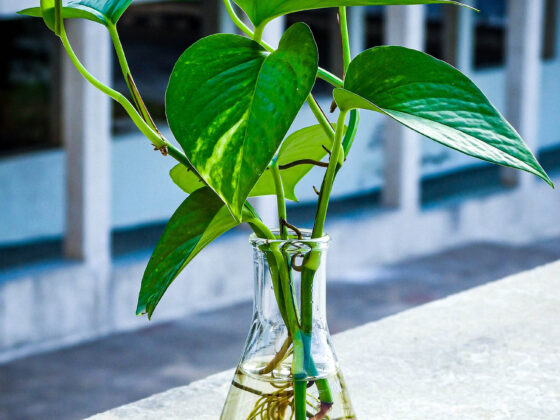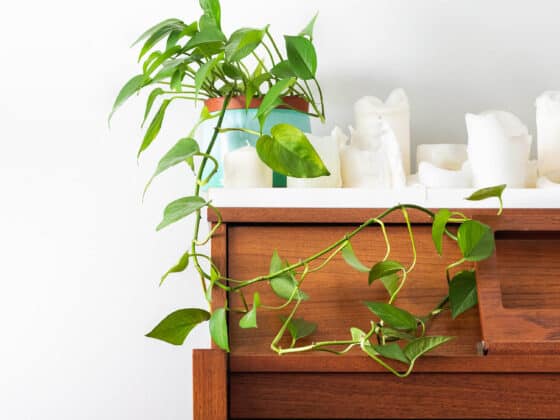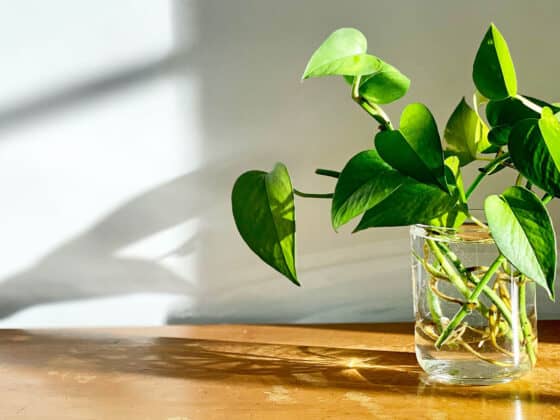A Devil’s Ivy, like most plants, can take root and survive in water. But what about when there are fish in the mix? Is it possible to grow a Pothos in an aquarium, or do they not play well with animals? Here’s our comprehensive guide to using Devil’s Ivy as an aquarium plant.
Pothos can live and even thrive in aquariums, and many fish will like having them around. The best way to grow Pothos in an aquarium is to leave most of the foliage above the surface. Start with a cutting and root it directly in the water. Prune it occasionally to keep it from taking over the tank.
Those basic instructions will get you started, but you probably have additional questions. What fish coexist well with Pothos? Can you grow the plant completely underwater? How can you keep your aquatic Pothos healthy? Just keep reading – we’ll answer all those questions and more below.
Will a Pothos Grow Well in Water?
If you’re like us, you don’t just want your plants to survive. You want them to live their best lives, producing tons of luscious foliage. Is that even possible when you grow a Pothos in an aquarium?
The answer is yes! Pothos plants can grow special underwater roots that can filter oxygen out of the surrounding liquid. Many houseplants can pull this trick off, but most of them will grow much more slowly than usual. A Pothos isn’t so picky. Plant it in water, and it will grow at its usual brisk pace, or close enough that you won’t notice the difference.
This is especially true when you grow Pothos in an aquarium, because fish poop is a natural fertilizer. Your Devil’s Ivy will soak up some of those nutrients, especially the nitrogen compounds that support robust foliage growth. A Pothos grown alongside fish will be even better off than one in a jar of plain water.
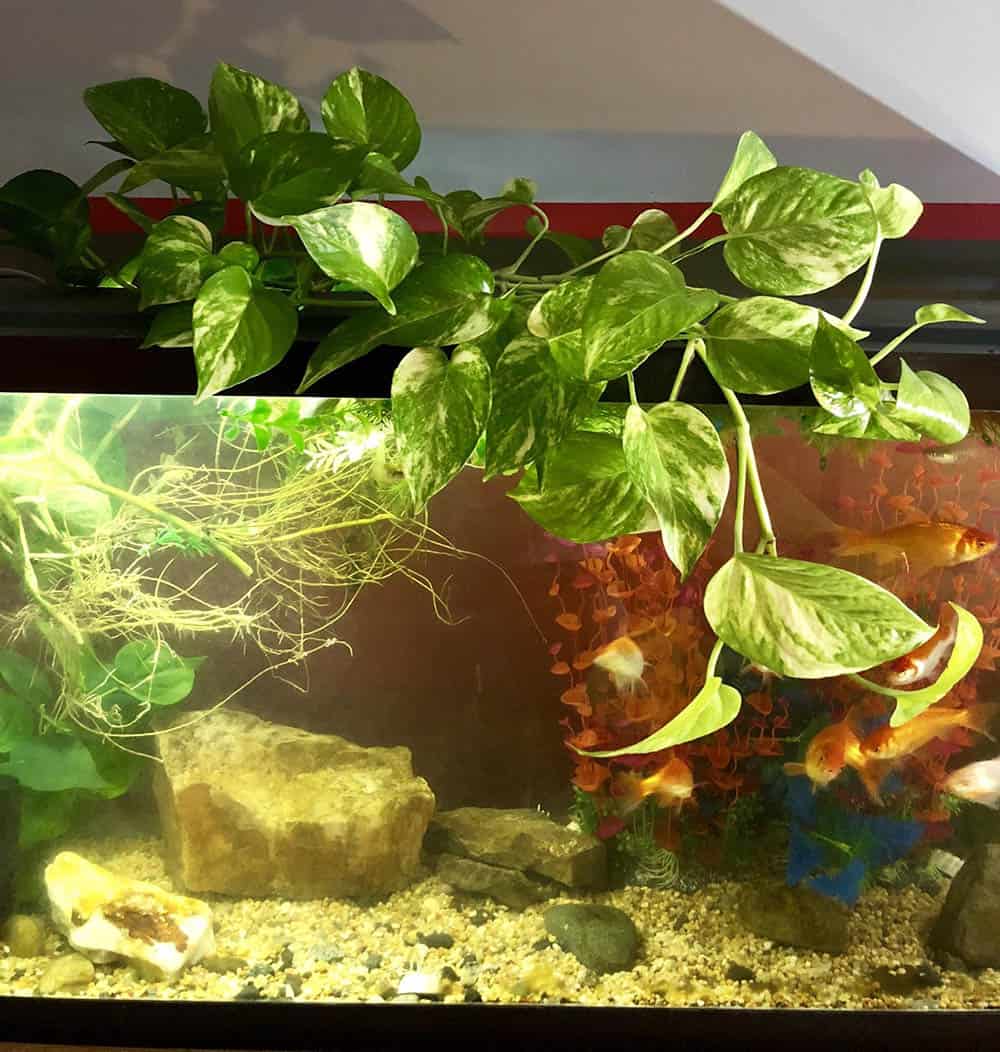
There is one important exception: Pothos won’t grow in saltwater tanks. They’re not adapted for it, and the excessive salt concentration will dehydrate their roots. A Pothos vine might not die right away in a saltwater aquarium, but its lifespan will be in months rather than years.
Can You Grow Pothos Fully Submerged?
Usually, when growing Pothos in water, you’ll keep the roots below the surface and the leaves above. The water is taking the place of soil or potting mix. However, if you’re used to raising fully submerged aquarium plants, you might wonder if you can grow Pothos underwater.
We don’t advise it. A Pothos can stay fully submerged for months without dying, and may even produce a few new leaves. However, it won’t produce the same kind of lush foliage you’d get from a healthy Pothos. And it probably won’t live as long as a plant on the surface.
Here’s a pretty good example of what happens when you try to grow a Pothos fully submerged. Over the course of 7 months, the plant in that video grows a few roots and one small new leaf. It also gets covered with algae, and a hole rots through one of its leaves.
If you just want some greenery in your tank for decoration, an underwater Pothos could work. It’s kind of a waste of this plant’s prodigious growth potential, though. Should you decide to go this route, make sure the tank gets plenty of indirect sunlight. You should also regularly wipe off the algae and prune away any dying leaves.
You don’t need to be concerned if some of your Pothos vines naturally dip under the water. Your plant should be fine as long as it has a good amount of foliage in the open air.
Is Pothos Poisonous to Fish?
“Wait a minute,” some of you might be saying. “Didn’t I hear somewhere that Devil’s Ivy is toxic? Is Pothos even safe for an aquarium?”
The toxicity of Pothos has become a little overblown on the internet. Like most plants in the Araceae, or “aroid” family, its vines, leaves, and roots contain calcium oxalate. These needle-sharp microscopic crystals can cause pain, irritation, and numbness, especially in mucous membranes.
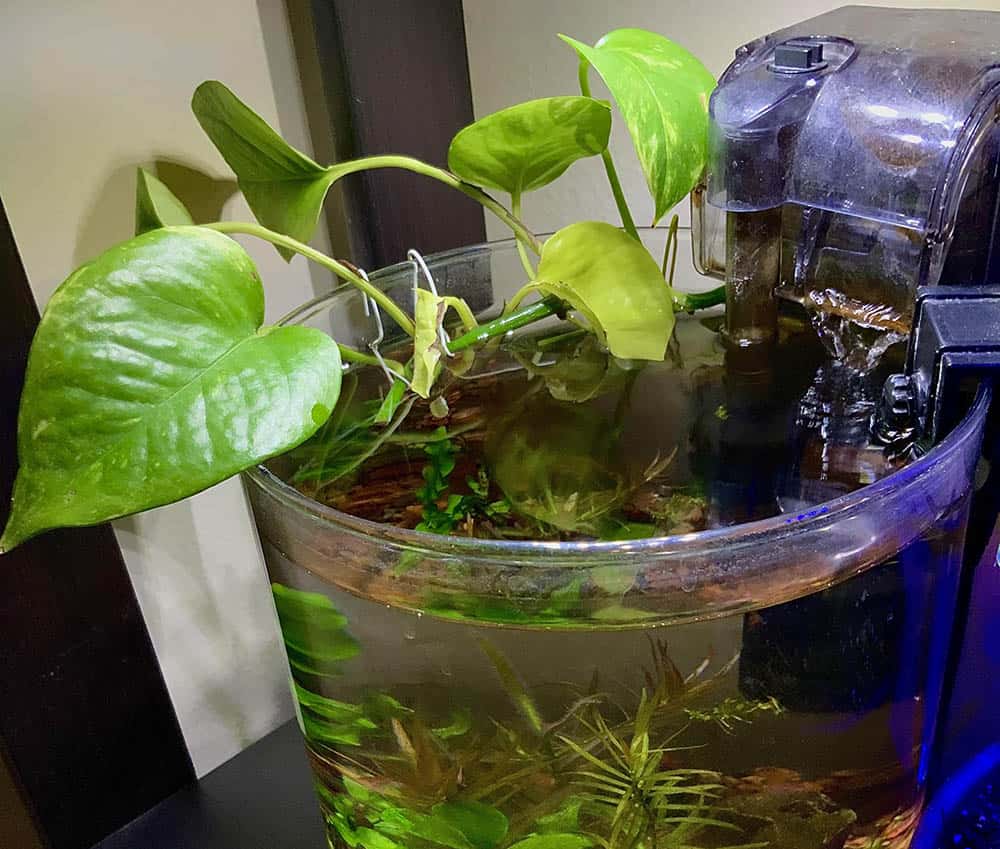
However, they virtually never cause lasting injury or death. Ingesting a large amount could theoretically cause throat swelling and difficulty breathing. Most animals that nibble on a Pothos will quickly get the message and stop, though.
If you want to be completely certain that your critters won’t get Pothos poisoning, stick to carnivorous fish. They won’t bother taking a bite out of your plants.
What Fish Go Well With Pothos in an Aquarium?
Devil’s Ivy can work with a wide variety of fish as long as there’s enough space in the tank. It’s especially alongside fish that evolved in tropical rivers. They like to hide and lay their eggs amid the curling roots and vines.
Here are a few good fish to use when you grow a Pothos in an aquarium:
- Tetras. These tiny, schooling fish come in a wide range of bright colors that stand out well against greenery.
- Angelfish and Discus. Unlike many African Cichlids, Angelfish don’t attack plants. They may challenge each other when they’re mating, but they won’t bother your Pothos.
- Rasboras. Another wide-ranging and colorful type of fish. The blue and orange Harlequin Rasbora is especially good for beginners.
- Gouramis. Gouramis are well-known for enjoying planted aquariums. Make sure you only have one male in the tank, though!
- Otocinclus. A miniature catfish that likes to cruise around the bottom of the tank eating algae.
- Killifish. This is another small, brightly colored fish that likes to spawn on plants. They prefer to eat live prey like brine shrimp and water fleas.
- Bettas. Often known as “fighting fish” for their fierce battles over mates, Bettas are also gorgeous and fond of hiding amid underwater plants. Don’t pair males with other male Bettas or species that resemble them. And make sure they have lots of room to roam.
The fish listed above generally like the same temperatures and pH as Pothos, but some specific subspecies have different needs. Always double-check the care requirements of the fish you’re choosing and make sure they’re compatible with Devil’s Ivy.
Will Goldfish Eat Pothos Roots? What About Cichlids?
Certain fish are notorious for chewing or digging up plants. Pothos have thick enough roots that they can survive a little nibbling. However, you might need some protective measures if your fish are particularly voracious. In that case, it may be better to root your Pothos in a hang-on-back filter rather than the main aquarium (more on this below).
Here are a few fish that love to munch on plants:
- Goldfish. These fish can be very destructive to plants. In addition to snacking on the leaves, they’ll often dig up the substrate at the bottom, uprooting anything growing there. Luckily, you can grow Pothos in an aquarium without planting them in the gravel, and a small amount of grazing won’t hurt their leaves or roots.
- Cichlids. Many plants can’t hang with these herbivores, but it’s usually okay to grow Pothos in a Cichlid tank. Again, though, it depends on the temperament of your fish – some of them will pester plants more than others.
- Plecos. Some Plecos are known for feasting on vegetation. They may chow the roots of your Pothos down to nubs. The good news is that they don’t seem to suffer ill effects from this, despite the exaggerated “poisonous” reputation of Devil’s Ivy.
Benefits of Pothos As An Aquarium Plant
Why grow Pothos in an aquarium? These plants provide several advantages for your underwater ecosystem:
Filtration
One of the biggest challenges in raising fish is that their waste ends up in the water where they swim. Over time, this can let harmful chemicals build up. Luckily, some of those chemicals are nutritious for your Pothos! Your plant is especially good at filtering out nitrates and ammonia. This makes the water less toxic for your fish and limits the growth of algae.
Keep in mind that even a large, mature Pothos can’t take the place of a filter or regular water changes. It will help keep your aquarium cleaner and healthier, though. And your Devil’s Ivy will get some valuable nutrition to boost its own growth.
Cover
We touched on this earlier. but many fish don’t like to live in a completely open environment. Freshwater species, in particular, tend to feel more comfortable around the thick roots and vines of a Pothos. This is especially helpful when you’re trying to breed your aquatic pets. Angelfish, Killifish, Tetras, Rasboras, and many other “egg scatterers” love to have hiding places for their eggs.
Aeration
When fish “breathe water”, what they’re really doing is filtering dissolved oxygen gas from the water. And any tank will run out of oxygen if it’s not regularly refreshed. This is one common reason for adding plants to aquariums. Leaves exhale oxygen underwater as well as in the air.
Pothos aren’t the most efficient plants for this purpose – most of their leaves will be above the surface, and they don’t photosynthesize as well underwater. Still, they’ll help your aquarium dwellers breathe a bit easier.
Beauty
Twisting vines and trailing roots provide a wild touch that can spruce up a plain glass tank. You use houseplants to decorate your own home – why not do the same for your fish? A spreading Pothos makes your aquarium look more like a natural habitat for your freshwater friends.
Where to Place Pothos in an Aquarium
There are three basic ways to set up your Pothos to grow in an Aquarium:
#1: Floating Roots
One option is to root your Pothos directly in the main tank of your aquarium, letting the foliage climb and trail over the sides. This is the way to go if you or your fish prefer a large cluster of roots dangling in the water. Egg scatterers like tetras will be especially happy with this arrangement.
You should still anchor your Pothos in place rather than letting it bob and drift. The simplest approach is to place a suction cup on one wall or clip the main stem to the rim of the tank.
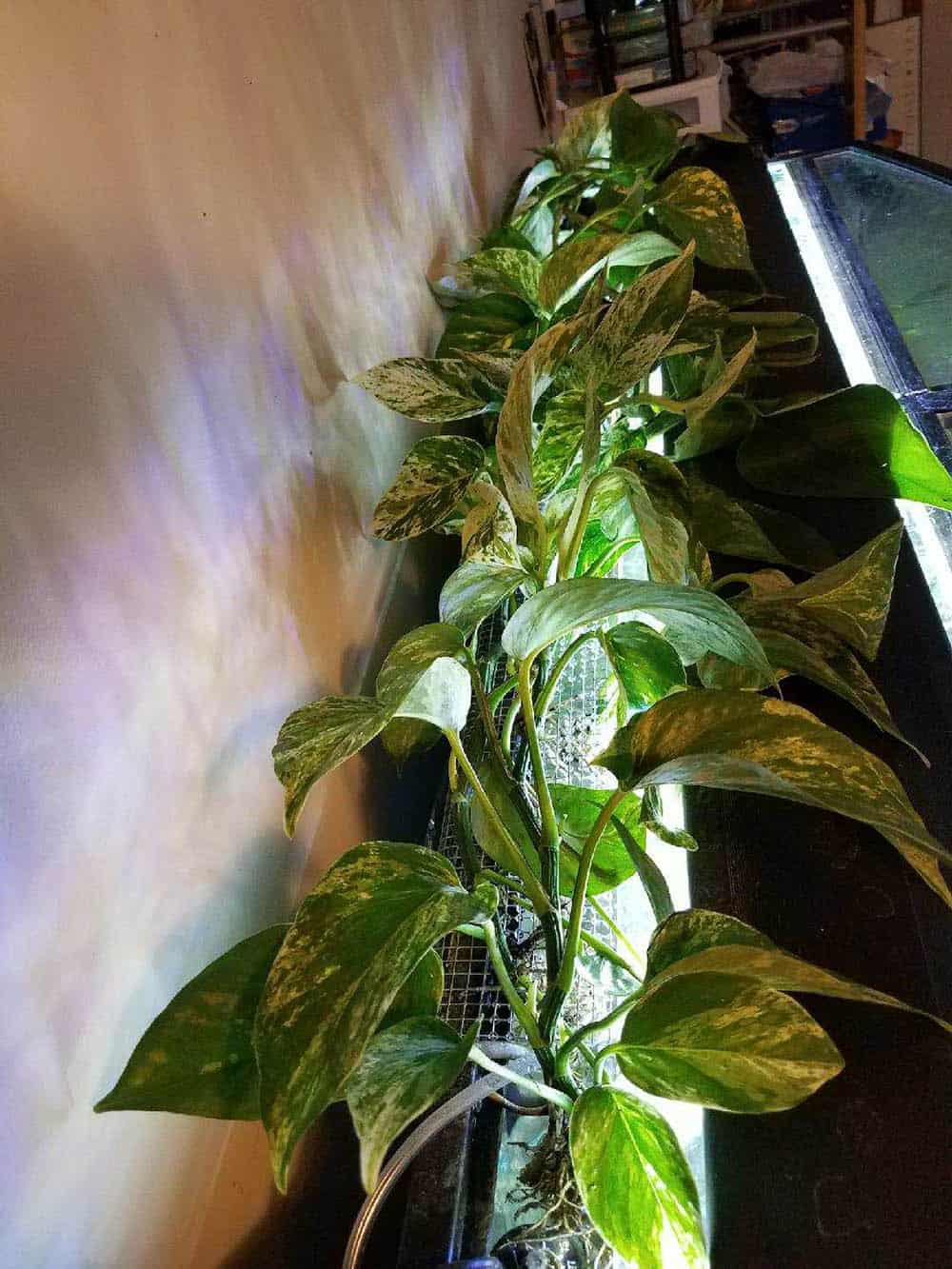
If you have an open-topped aquarium, you could also lay some type of stiff grid or lattice on top. Then snake your Pothos vine through the gaps. Most aquarium shops will sell simple plastic divider grids (sometimes called “egg crate material”) that work well for this purpose. For closed aquariums, you could drill holes for your Pothos vines through the plastic strip at the back of the lid.
#2: Rooted in Substrate
Lots of water-dwelling plants live with their roots in the bed of a river or lake. Though Devil’s Ivy isn’t normally aquatic, it can grow this way too. This helps to anchor the plant. It also boosts growth since, since your Pothos can feed on the highly concentrated nutrients that settle to the bottom of the tank.
Ordinary houseplant soil or potting mix won’t work in a tank. Instead, use aquarium substrate, which is made for this precise purpose. Make sure your Pothos vine is long enough that some of the leaves will reach past the surface.
#3: Floating in the Filter
What if you want to keep your aquarium mostly clear so it’s easy to see your fish? Or you’re worried about a Pleco or a Goldfish tearing up the roots? In that case, you can plant your Pothos in a hang-on-back (HOB) filter. This comes in the form of a smaller plastic box that you clip onto the back of your aquarium, with a tube running into the main tank. You can let your Pothos roots grow there while the vines creep over the top of the aquarium.
Your plant’s roots have less room to grow in a filter, so it may not quite get quite as large. You’ll also need to avoid letting the roots tangle up the filter motor.
A typical HOB is set up with two chambers – a smaller one containing the intake mechanism and a larger one with a sponge or carbon fiber filter. You’ll want to place your Pothos in that second chamber. The roots might still try to grow into the motor, so it’s important to check on them and trim them occasionally.
Letting Your Aquarium Pothos Climb
As you may have guessed from the name, Devil’s Ivy loves to climb. In nature, they snake up the sides of trees to reach the sunlight. When you grow a Pothos in an aquarium, it’s often good to give it something to cling to.
This serves a couple of purposes. First, you can steer your plant away from stuff you don’t want it to grab, like hanging lights or power cords. Second, you can create some very neat visual effects over time. It’s cool to see a big Pothos plant crawling across a wooden lattice or up a copper pole.
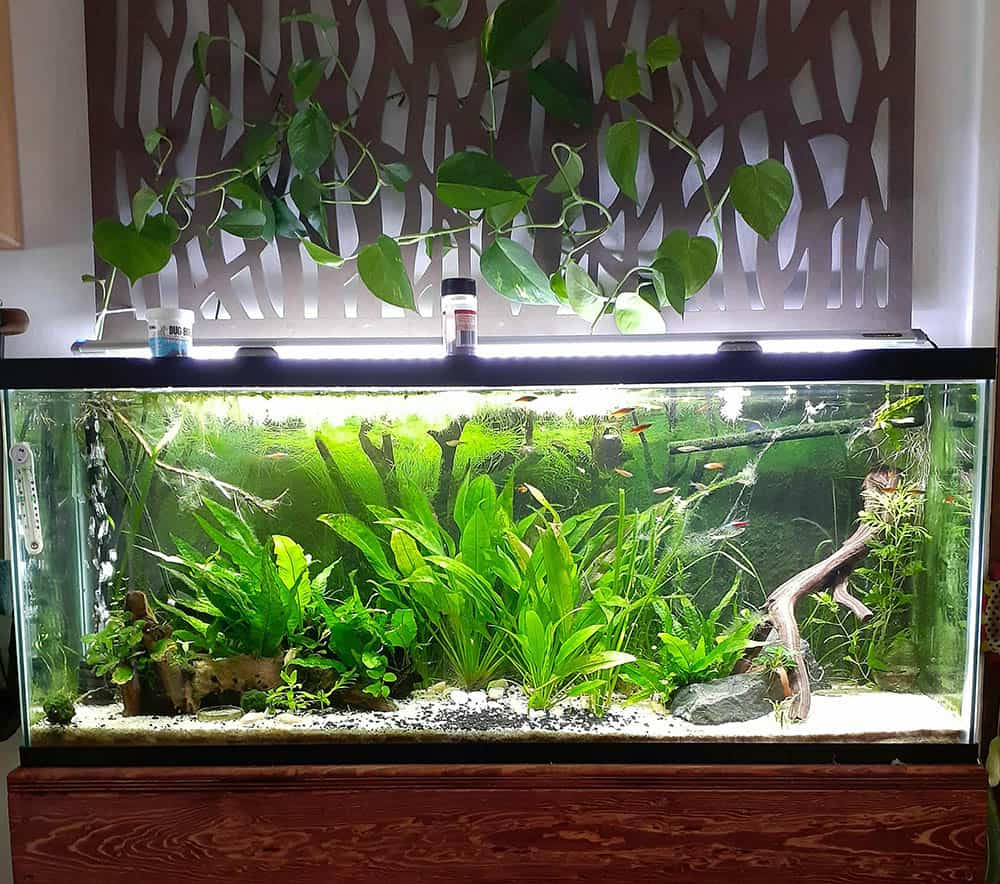
Getting your Pothos to climb doesn’t require much fancy equipment. These plants will latch onto pretty much anything, from bare PVC pipes to elaborate custom-made trellises. You may need to help your Pothos find its way there at first. Tie one of the vines to the stick, grid, or lattice with some garden twine. It won’t take your plant long to start exploring.
How to Set Up a Pothos in an Aquarium
Once you’ve decided where in the tank your Pothos will go, how do you get it there? The best method is to start with a cutting (or a bunch of cuttings) and let them grow roots in the water. Otherwise, you’ll have to uproot your plant and carefully wash off the soil and fertilizer before transferring it. And you’ll still have to wait for it to form water roots before it can get growing.
Step 1: Cut Your Pothos
Disinfect a pair of pruning scissors with rubbing alcohol or a 10% dilution of bleach. Then snip some stems off of your Pothos. Take as many as you want and you think the plant can spare. It’s usually best not to remove more than ⅓ of the foliage at once.
Each cutting should be long enough that several nodes will be under the surface and a few leaves will be above it. If you’re not familiar with the term, a node is one of those bumpy joints along the vine. New roots and leaves can only come from nodes.

If you’re placing your cuttings in the filter or the top of the tank, they can be fairly short. They’ll need to be a lot longer if you want to anchor them in the substrate. (You could also start with the first method and just wait for the roots to grow to the bottom.) Wherever you choose to cut, try to do it in one smooth motion.
Step 2: Root Your Pothos
Rinse the stems before transferring your Pothos in case there are any traces of soil or chemical fertilizer on them. Then place it in your tank and fix it in place somehow. The simplest, cheapest way is to loop a little bit of coated wire around the stem just below a leaf node. Bend the ends of the wire over the tank’s edge, creating a little hook, and you’re good to go! Never use bare wire for this – it can rust and mess up the chemical balance of the water.
Some guides recommend placing the cuttings in a separate jar until their roots are 4-5 inches long. However, there’s no reason you can’t put them straight into the aquarium. The one exception is if you want to plant your Pothos in the aquarium gravel right away. In that case, you’ll want to have some roots you can bury in the substrate.
Either way, once you put your Pothos in water, they should start to grow roots within a few days. We suggest placing the plant near the back of your aquarium. Devil’s Ivy tends to spread like wildfire, and you want to make sure you can still see your fish!
Step 3: Monitor Your Pothos
Keep an eye on your plant over the next week or two. Pothos cuttings almost always take root and grow in water, but there’s a small chance that they’ll fail to thrive. If the cutting shrivels up and starts turning brown, take it out of the water right away.
After 7-14 days, you should start to see small whitish nubs peeking out of the underwater nodes. Those are the beginnings of the roots. Once those appear, all that’s left to do is tend your Pothos and your aquarium as normal.
How to Care For Pothos in an Aquarium
When you grow a Pothos in an aquarium, what does it need to stay happy? Here are a few key care tips:
Keep Your Pothos Well-Lit
Pothos appreciate bright, indirect light. Your plant will grow faster and stronger the more sun you provide, as long as the rays aren’t hitting leaves dead-on. A grow lamp can be a good substitute if your aquarium isn’t in a sunny room.
Watch For Algae and Rot
Pothos are fast growers that very efficiently filter nitrates out of the water. In many cases, they don’t leave enough nutrients to allow algae buildup! But you should keep an eye out for it just in case. Too much algae growth can smother the roots or underwater leaves.
Check regularly for green fuzz on the underwater parts of your Pothos. If you catch it early, you can rub it off with your fingers. More severe algae growth might call for a gentle scrub with a toothbrush.
You should also monitor your plant for dead or dying leaves and remove them before they start to rot. It’s not good for your fish to be swimming in decaying plant matter. Foliage in aquarium water can occasionally suffer from plant melt, turning brown, mushy, and translucent.
That sounds scary, but in many cases, it only happens to one or two leaves. Plant melt can be caused by chewing damage from fish, excessive nitrogen waste, or failure to prune dying leaves. Whatever the cause, the fix is to immediately remove any melting tissue.
Prune Your Pothos Regularly
Even healthy Pothos leaves and roots can be a nuisance if they get overgrown. It’s up to you how far to let your plant spread, of course. Still, no matter where you set the boundary, your Pothos will probably try to creep across it.
The good news is that you can prune this plant back quite aggressively without hurting it. The trimmers in this aquascaping tool set should work nicely. Clip the roots and leaves of your Pothos whenever they start to grow too long.
Aerate and Filter the Water
This is good advice for any aquarium, but it’s worth remembering that your Pothos roots need air too. And your Devil’s Ivy is less likely to suffer from plant melt when you make sure that the concentrations of nitrates and ammonia remain low. The plant itself provides some oxygenation and filtration, but it may not be enough on its own.
If you’re using an automated filter that’s properly rated for your tank size, your aeration and filtration needs should be covered. Otherwise, make sure you change out the water regularly. Each week, dump out 10-20% of the water and pour in some more. It may also help to add an air stone or another mechanism to aerate your aquarium.
Fertilize When Necessary
Your Pothos will absorb a decent amount of nutrition from the waste your fish produce. But it’s hard to be certain that your animals will provide enough fertilizer to sustain your plant.
This is especially true if you grow Pothos in an aquarium alongside other plants. Devil’s Ivy grows rapidly and uses a lot of nutrients. Some people have even reported that it leaves too little for their other aquarium plants!
You can supplement your plant’s diet with small doses of aquarium plant fertilizer. As long as you don’t overdo it, this stuff will nourish your Pothos without affecting your fish. Start small, with ¼ of the concentration recommended in the instructions. Add it to your aquarium’s water every 4-6 weeks. If the plants in the tank seem sluggish or malnourished, you can increase the dosage little by little.
Keep the Temperature Mild
This shouldn’t be too hard to remember, since Pothos like roughly the same temperatures as your fish. Keep the water in the tank and the surrounding air between 70 and 80 degrees, and your plant should be happy.
Monitor the pH
Again, this is good advice even for a plant-free aquarium. Test the pH regularly to make sure that it’s in the right range. Pothos (and the fish we suggested above) appreciate water that’s neutral or slightly acidic. In general, you should shoot for a pH range of 6.0-7.0. Check the preferences of your specific fish, though.
Final Thoughts
You’ll benefit both your plant and your fish when you grow Pothos in an aquarium. As long as you maintain it right, your Devil’s Ivy will make an excellent addition to your freshwater ecosystem. And you’ll love the visual flair that its lush vines add to your tank.






